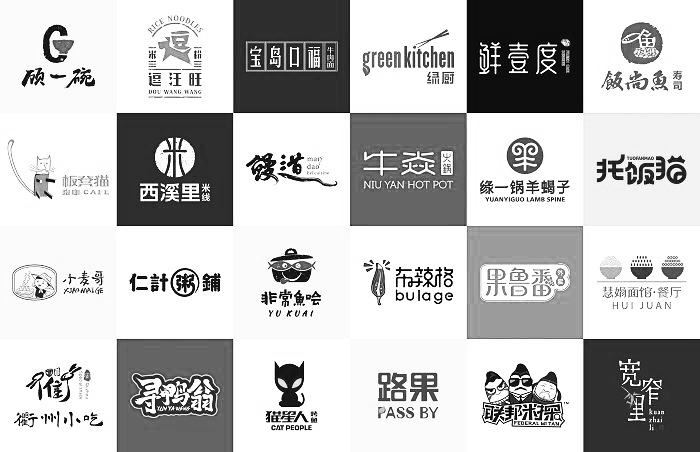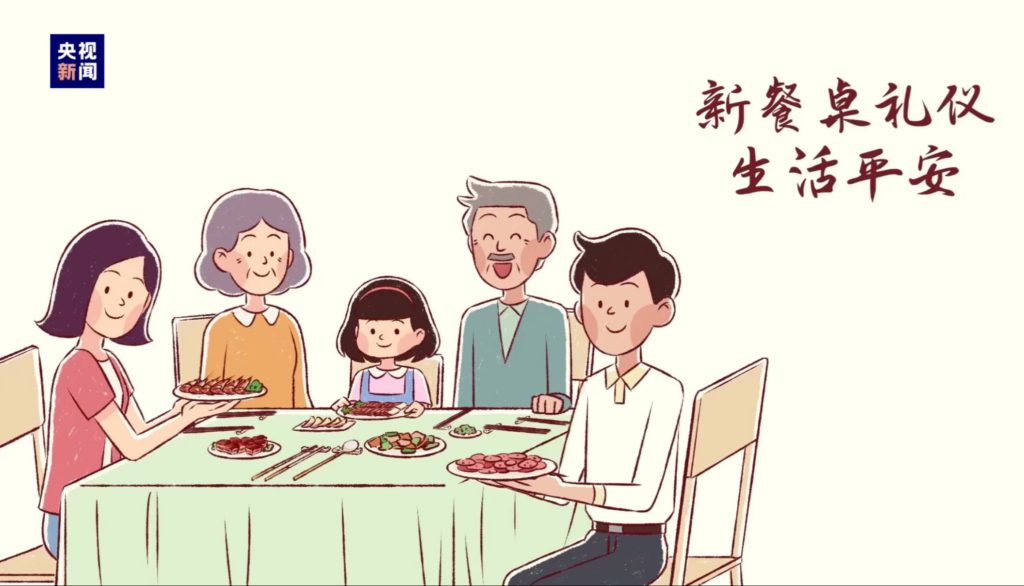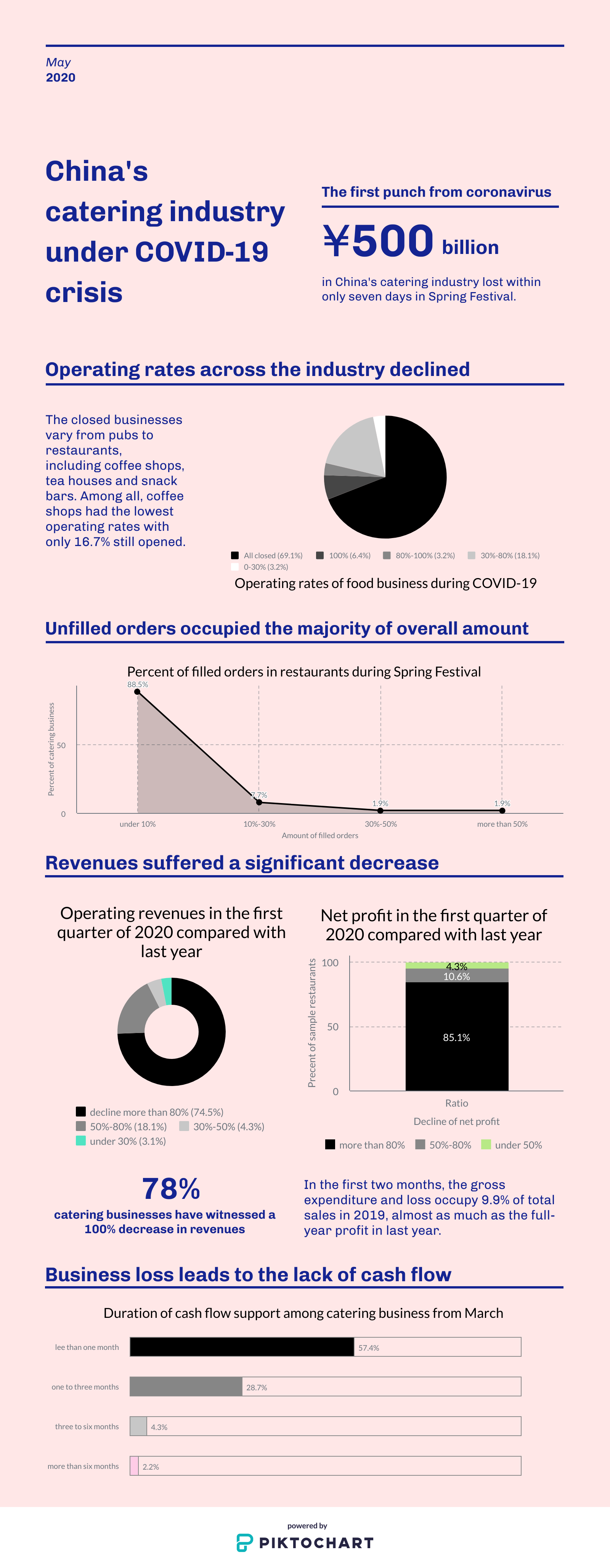Over 70% restaurants in China are severely impacted due to The COVID-19 Crisis. What does the catering industry struggle with and how can it overcome the difficulties and make a survival?

The last 30 days were probably the least busy times for Linquan (pseudonym) since she started working in Hangzhou’s Bakery. Shops were forced to close, plans for new stores had been postponed indefinitely, the city seemed to stay asleep from day to night, and she would only think of herself as an employee when joined the online discussion about surviving their store under COVID-19.
“Everything is out of control and we have to reconsider our following scheme,” Linquan (pseudonym) said, “As it’s hard for us to bake at home, we’re not able to provide delivery at the moment. But we have thought about introducing new products, launching promotions during quarantine.”
With the help of the pent-up desire for consumption, these measures worked well on the first few days after they reopened. The workloads seemed more than double compared to usual. Chairs were stacked together as no one actually had time to sit in. Sometimes the phone rang with reservations came and disrupted the busy pace. Slightly past three, the bread had been fully sold out, and this was five hours earlier than the normal closure time.
In fact, many shops have experienced “retaliatory consumption” from consumers after resuming business. Especially in Wuhan, after quarantine ended, a time-honored hot dry noodle shop sold over 50 kilograms of noodles within one day. Apart from customers who were waiting outside the shop, there were many delivery riders as well.

However, caused by the pent-up desire and pricing promotions, this sort of “retaliatory consumption” is merely a temporary solution under the worse circumstance——78% of restaurants lost 100% of their revenue, and there were only 5% that lost less than 70%. In addition, as more and more restaurants open, consumption groups are dispersed, and consumers gradually return to a state of rationality.
“Actually the passion for consumption is very limited and this definitely does not go far enough to cover our loss during the closure.” Linquan (pseudonym) said. It seems that if businesses strive to minimize loss during the epidemic period, they need to think about more solutions more earlier, even before quarantine started.
Most restaurants chose to produce delivery food without physical touch during quarantine, and in order to reassure consumers of safety, shops posted their own disinfection measures and their staff’s temperature taking charts every day. One renowned muffin shop in Shanghai even shared their recipes on Weibo, and sold ingredients to enable bored customers to try out homemade cakes at home.

“I think this practice is quite interesting as I’m personally big on baking and it gives me a sense of achievement,” Li Yitong, a customer who is a fan of the shop said, “The restaurant owner is quite smart as they effectively made use of over-stored ingredients in their shops, and they gained more popularity and exposure through our pictures of finished products.”
After the peak of the epidemic, facing the retaliatory consumption from customers, some shops adopted “retaliatory price hike” to make up for their losses. For example, Haidilao hotpot increased its prices by as high as 6%, and this triggered great controversy after one customer in Beijing shared a per capital bill of 220 RMB. Although the controversy ended with Haidilao apologizing and the price returning to normal, this shows that price hike cannot help the food industry to achieve sustainable development.
Song Xiangqing, vice chairman of The Commerce Economics Association of China said: “Given the current situation where the market has not fully recovered, the supply still overwhelms the demand. As a result, higher prices will deter consumers from buying from your store.”
Actually, this is not the first time for the catering industry to face such a major challenge. Whether it be the SARS in 2003 or the global financial crisis in 2008, every blow to the industry has led to alterations in operating models and structural transformations at an industry level. If restaurants can seize these opportunities, they might be able to survive and flourish in the long term.
According to the research conducted by the CCFA on 71 leading chain corporate groups, 67.6% of food enterprises plan to upgrade their supply chain or to engage in digital transformation. For companies that mainly engage in offline retail services, most of them have switch to online marketing. On top of collaborations with fixed delivery platforms, they have also established connections with potential customers using WeChat groups and WeChat moments.

Centralized data flow might bring about price advantages while privatized data flow can produce more unique advantages, thus it is better able to meet consumers’ needs. And WeChat community is a representative example that establishes privatized data flows.
Geng Zhijun, vice president of Wei Xin Group of Tencent.
Li Heng, starter of Heng’s Dumpling, opened online stores half a year in advance due to the outbreak of COVID-19. Now he has three to four fan groups on WeChat for every chain store to better understand consumer needs and to publicize new products. He even started to engage in online streaming on TikTok to close the gap between him and customers. There are also frontier warehouses added to physical stores so that restaurants and retailing can run concurrently.
While those large-scale enterprises have found a way to get through, many self-employed small businesses are facing more challenging problems such as expiring contracts and pressure to afford rents. Merely a few days after businesses have restarted, three independent cafes have declared closure in Hangzhou.

A store located in a large office building was forced to suspend their business as it was too hard to carry out delivery services given the strict control imposed on personnel’s coming in and out of the building. Another store could no longer continue its service because its barista has been trapped in Hubei Province.
Compared with others, the coffee shop called Random was more fortunate. Despite the termination of rental contracts, spaces rented for exhibition were put into use. They removed all their equipment from the original store and planned to transform the space into a team office. Besides keeping their coffee tables, they will be starting new services in the future.
Transformation seemed to become a norm after every blow for every industry. As early as 2008, physical bookstores affected by the wave of e-commerce started to re-allocate their spaces at an unprecedentedly large scale. By introducing coffee, pastries, cultural and creative product lines, physical bookstores finally succeeded in keeping their consumer bases.
Today, those surviving cafes and bakeries started to plan for the worst as well. Some stores declared that they will be launching designs with their Logos including mugs, recycled bags, T-shirts and postcards. Others have marched into the art industry and collaborated with niche brands to hold good product sharing online.
Although the epidemic has brought about losses to the sales revenue, it also provides a new direction for us to think about the development of the catering industry and how to progress further from here by diversifying our products.
Jiang Jing (pseudonym), a cafe operator in Hangzhou.
Besides, the crisis also witnessed progresses of the whole industry and led it to a new developmental stage. In earlier times, eateries have enforced individual serving for all customers under governmental policies. With more restaurants resumed, this tedious measure has gradually formed a new culture. Green, health and safety become leading consumption concepts that influence people’s dining habits.

“Although individual serving has created many new troubles for restaurants, we have refined our organizing structures through the process, Zhang Chunliang, president of Shandong Lan Hai Hotels Corporation said, “In the past, busboys were under the lead of waiters. Now they take orders directly from the kitchen and involve in preparing the dishes, which has improved the efficiency of our service.”
Currently, the infection curve in China has gradually flattened. For the food industry, every choice business owners make, be it to navigate deeper into online marketing or to explore with industrial transformation and service innovation, means to overcome the challenges and emerge stronger and better from the crisis.
Just like Wang Wenjiang, deputy secretary of World Federation of Chinese Catering Industry said: “As long as we seize the opportunity to develop by improving the level of healthiness, experimenting creative servicing modes and reinforcing brand loyalty, the catering industry will be able to brace the challenge and achieve high-quality developments.”

